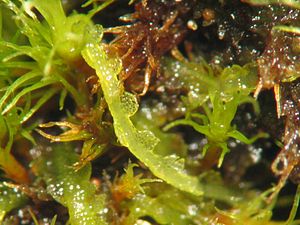Bog head moss
| Bog head moss | ||||||||||||
|---|---|---|---|---|---|---|---|---|---|---|---|---|

Bog head moss ( Cephalozia connivens ) |
||||||||||||
| Systematics | ||||||||||||
|
||||||||||||
| Scientific name | ||||||||||||
| Cephalozia connivens | ||||||||||||
| ( Dicks. ) Lindb. |
The bog-headed moss ( Cephalozia connivens ) is an inconspicuous, tiny moss that usually grows between other mosses in bogs .
description
The plants are colored pale yellow to light green. They are only about 1 mm wide. The tips of the stems are often somewhat swollen with leaves.
The elongated, rounded flank leaves are approx. 0.6 mm wide and usually 7 to 10 cells wide at the base. They are divided into two lobes for a third to half their length, the blunt tips of which are inclined towards one another. The lamina cells are relatively large (30 to 50 µm wide and 55 to 70 µm long) and more or less hexagonal. As a rule, they contain no, sometimes tiny, oil bodies.
The species often fruits in spring. The perianth mouth is slit, while the two lobes of the bracts are entire. The species also reproduces vegetatively through brood bodies.
Distribution and location requirements
The species grows in oligotrophic , acidic, moist locations in raised and intermediate bogs, on peat , on the edges of ditches, and rarely also on rotten wood. Since the species is closely tied to such locations, it is particularly threatened by the destruction of its habitat. It grows between other mosses or in thin coatings, often together with Campylopus pyriformis , Dicranodontium denudatum and Sphagnum species.
The species occurs in Europe and North America. In Central Europe it grows mainly in the moors of the flatlands. It is rare in the mountains and low mountain ranges.
Sources and web links
- Jan-Peter Frahm , Wolfgang Frey : Moosflora. Verlag Eugen Ulmer, Stuttgart 1983, ISBN 3-8001-2463-7
- Nebel, Philippi: Die Moose Baden-Württemberg Volume 3 (Ulmer Verlag, 1st edition, 2005 ISBN 3-8001-3278-8 )
